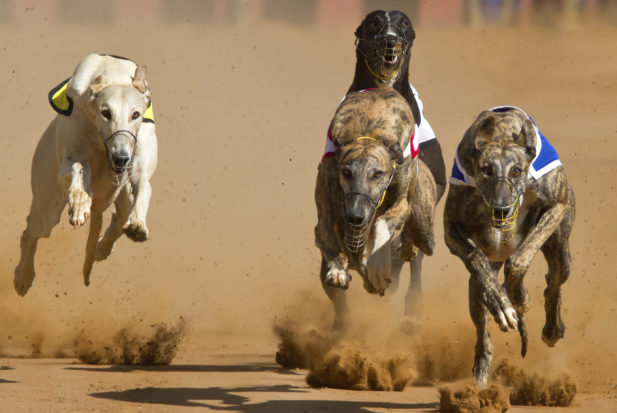
When it comes to greyhound racing, government should be part of the solution rather than the enabler of a problematic industry. Photo by iStockphoto
In Florida, the hub of a withering U.S. greyhound racing industry, regulators identified 12 greyhounds with cocaine in their blood at the Bestbet Orange Park near Jacksonville, according to The Washington Post and First Coast News. One trainer, Charles McClellan, handled all of the dogs, an incriminating fact pattern. Cocaine is just one of many drugs discovered in racing dogs, and this illegal substance is apparently administrated as a stimulant by cheaters within the industry.
While there’s definitely a way to juice the dogs – even if it’s illegal and underhanded — there’s little the industry has been able to do of late to juice up the sport. It’s been in steep decline, and nobody in the industry really thinks that this trajectory is reversible. Twenty-five years ago, there were more than 60 tracks in the United States with a handle of $3.5 billion, while today, greyhounds run on sand at only 19 tracks, and the handle is only $500 million. Florida is the industry’s last bastion with 12 tracks, including the Jacksonville facility.
The unusual circumstance of the current moment is that dogs typically run in front of empty, or near empty, bleachers at these 19 tracks. The base of fans interested in watching a pack of dogs chasing a mechanical lure around the short oval, in a mad-dash sprint that lasts only about 30 seconds, is small and shrinking.
How do businesses with so few patrons continue to operate?
One answer is they cannot operate well, and that’s why we’ve seen dozens of tracks shuttered. That trend has been aided by animal advocacy groups, led by GREY2K USA, that have helped ban the sport in 40 jurisdictions.
The surviving tracks are not standing on their own two, or four, feet. Rather, state and casino-gaming interests are the reason the tracks remain open, even as the base of spectators recedes.
Florida requires that the dog tracks run a minimum number of days. And casino-gaming interests pay the freight.
Casino gaming companies expanded into more communities in the United States with their games of chance (e.g., blackjack, slots, and other conventional forms of gambling) by developing relationships with dog- and horse-racing tracks. In return for the establishment of gambling in new markets, the casinos promised to subsidize the racing. The tracks were foresighted and went to state legislators to require a minimum number of race days, so that breeders and other players within the industries could continue to operate.
Horse racing remains a viable industry and sport, although it has its own doping problems (The HSUS and The Jockey Club are collaborating on federal legislation to end doping and put the U.S. Anti-Doping Agency in charge of a regulatory program to clean the sport of non-therapeutic drugs). But almost everybody agrees that there’s no saving greyhound racing.
The question is, how long will these 19 tracks operate, and what’s the pathway to phase them out?
The first step is to decouple casino gambling and racing. End the required race days.
It’s time for the casinos and the animal advocacy groups to join together to unwind greyhound racing in an orderly way and to protect the dogs. When that’s achieved, we’ll have stopped the doping. Stopped the on-track injuries. And stopped the flood of retired greyhounds into the adoption pipeline, denying other needy animals safe havens.
When it comes to greyhound racing, the market should be allowed to work, and government should be part of the solution rather than the enabler of a problematic industry. It’s been propping up a declining sport for too long. It’s time for serious-minded people to get together and head toward the exits.
The post Doping scandal adds to reputational issues for greyhound racing industry appeared first on A Humane Nation.
Enviroshop is maintained by dedicated NetSys Interactive Inc. owners & employees who generously contribute their time to maintenance & editing, web design, custom programming, & website hosting for Enviroshop.
